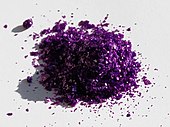Chromium compounds

Chromium compounds are compounds containing the element chromium (Cr). Chromium is a member of group 6 of the transition metals. The +3 and +6 states occur most commonly within chromium compounds, followed by +2; charges of +1, +4 and +5 for chromium are rare, but do nevertheless occasionally exist.[3][4]
Common oxidation states
| Oxidation states[note 1][4] | |
|---|---|
| −4 (d10) | Na4[Cr(CO)4][5] |
| −2 (d8) | Na 2[Cr(CO) 5] |
| −1 (d7) | Na 2[Cr 2(CO) 10] |
| 0 (d6) | Cr(C 6H 6) 2 |
| +1 (d5) | K 3[Cr(CN) 5NO] |
| +2 (d4) | CrCl 2 |
| +3 (d3) | CrCl 3 |
| +4 (d2) | K 2CrF 6 |
| +5 (d1) | K 3Cr(O 2) 4 |
| +6 (d0) | K 2CrO 4 |
Chromium(0)
Many Cr(0) complexes are known. Bis(benzene)chromium and chromium hexacarbonyl are highlights in organochromium chemistry.
Chromium(II)

Chromium(II) compounds are uncommon, in part because they readily oxidize to chromium(III) derivatives in air. Water-stable chromium(II) chloride CrCl
2 that can be made by reducing chromium(III) chloride with zinc. The resulting bright blue solution created from dissolving chromium(II) chloride is stable at neutral pH.[6] Some other notable chromium(II) compounds include chromium(II) oxide CrO, and chromium(II) sulfate CrSO
4. Many chromium(II) carboxylates are known. The red chromium(II) acetate (Cr2(O2CCH3)4) is somewhat famous. It features a Cr-Cr quadruple bond.[7]
Chromium(III)

A large number of chromium(III) compounds are known, such as
(radius 50 pm), and they can replace each other in some compounds, such as in chrome alum and alum
Chromium(III) tends to form
Chromium(III) hydroxide (Cr(OH)3) is amphoteric, dissolving in acidic solutions to form [Cr(H2O)6]3+, and in basic solutions to form [Cr(OH)
6]3−
. It is dehydrated by heating to form the green chromium(III) oxide (Cr2O3), a stable oxide with a crystal structure identical to that of corundum.[6]
Chromium(VI)
Chromium(VI) compounds are oxidants at low or neutral pH. Chromate anions (CrO2−
4) and dichromate (Cr2O72−) anions are the principal ions at this oxidation state. They exist at an equilibrium, determined by pH:
- 2 [CrO4]2− + 2 H+ ⇌ [Cr2O7]2− + H2O
Chromium(VI) oxyhalides are known also and include chromyl fluoride (CrO2F2) and chromyl chloride (CrO
2Cl
2).[6] However, despite several erroneous claims, chromium hexafluoride (as well as all higher hexahalides) remains unknown, as of 2020.[12]

Sodium chromate is produced industrially by the oxidative roasting of chromite ore with sodium carbonate. The change in equilibrium is visible by a change from yellow (chromate) to orange (dichromate), such as when an acid is added to a neutral solution of potassium chromate. At yet lower pH values, further condensation to more complex oxyanions of chromium is possible.
Both the chromate and dichromate anions are strong oxidizing reagents at low pH:[6]
- Cr
2O2−
7 + 14 H
3O+
+ 6 e− → 2 Cr3+
+ 21 H
2O (ε0 = 1.33 V)
They are, however, only moderately oxidizing at high pH:[6]
- CrO2−
4 + 4 H
2O + 3 e− → Cr(OH)
3 + 5 OH−
(ε0 = −0.13 V)

Chromium(VI) compounds in solution can be detected by adding an acidic
5·OR
2.[6]
Other oxidation states
Compounds of chromium(V) are rather rare; the oxidation state +5 is only realized in few compounds but are intermediates in many reactions involving oxidations by chromate. The only binary compound is the volatile
Compounds of chromium(IV) are slightly more common than those of chromium(V). The tetrahalides, CrF4, CrCl4, and CrBr4, can be produced by treating the trihalides (CrX
3) with the corresponding halogen at elevated temperatures. Such compounds are susceptible to disproportionation reactions and are not stable in water. Organic compounds containing Cr(IV) state such as chromium tetra t-butoxide are also known.[14]
Most chromium(I) compounds are obtained solely by oxidation of electron-rich,

Notes
- ^ Most common oxidation states of chromium are in bold. The right column lists a representative compound for each oxidation state.
See also
References
- PMID 15092973.
- ^ Puigdomenech, Ignasi Hydra/Medusa Chemical Equilibrium Database and Plotting Software Archived 5 June 2013 at the Wayback Machine (2004) KTH Royal Institute of Technology
- ^ Clark, Jim. "Oxidation states (oxidation numbers)". Chemguide. Retrieved 3 October 2018.
- ^ ISBN 978-0-08-037941-8.
- ISBN 978-1-119-95143-8.
- ^ ISBN 978-3-11-007511-3.
- ISBN 978-0-19-855649-7.
- ^ "Chromium(III) compounds". National Pollutant Inventory. Commonwealth of Australia. Retrieved 8 November 2018.
- . Retrieved 8 November 2018.
- ISBN 978-1118851371. Retrieved 2019-08-07.
- PMID 31967803.
- PMID 25418862.
- ^ Haxhillazi, Gentiana (2003). Preparation, Structure and Vibrational Spectroscopy of Tetraperoxo Complexes of CrV+, VV+, NbV+ and TaV+ (PhD thesis). University of Siegen.
- ISSN 0020-1669.
- S2CID 42853922.
